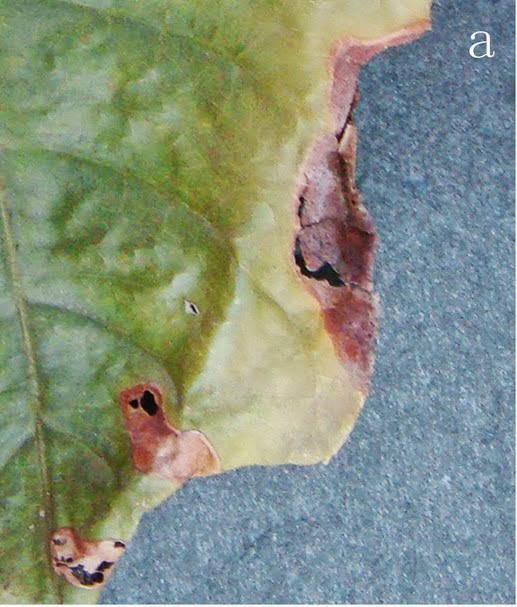Guavas, Psidium guajava,
are fruit bearing trees in the Myrtle Family, Myrtaceae, closely related to Eucalyptus. They are native to Mexico,
Central America and the Caribbean Islands, but have been introduced to many
countries as a commercial fruit crop, the largest producers being Mexico, India
and Brazil. Like most commercially grown fruit trees, Guavas are prone to a
variety of fungal diseases. Anthracnose causes blackening, mummification and
rotting of fruit, which is caused by the fungus Colletotrichum gloeosporioides; this has been reported to have
caused the loss of 50% of the annual crop in Puerto Rico, and is widespread in
many other Guava-growing countries. Guava Dry-Rot is caused by the fungus Lasiodiplodia theobromae, and affects as
much as 40% of the Guava crop in parts of South India.
In South Africa around 40 000 tonnes of Guava are produced annually.
The crop here has been reported to suffer from Anthracnose, Blossom End Rot,
which is caused by the fungus Phomopsis psidii,
and Pink Spot. Pink Spot starts as small pink or red spots on the surface of
the Guava fruit and leaves, which grow over time and eventually rot. The fungus
Colletotrichum gloeosporioides (the
cause of Anthracnose) has been recovered from large, rotten Pink Spot patches,
and was thought to be the cause of this disease too, but it has not been
isolated from less advanced cases, and is now thought to be a secondary
infection taking advantage of weakened plants.
In a paper published in the South African Journal of Science on 22
September 2014, Adriaana Jacobs and Mariette Truter of the Biosystematics
Programme of the Plant Protection Research Institute of the South AfricanAgricultural Research Council and Maritha Schoeman of the Crop ProtectionProgramme of the Institute for Tropical and Subtropical Crops of the South
African Agricultural Research Council discus the results of a study of Guava
Pink Spot from plants growing at Nelspruit in Mpumalanga Province, South Africa,
which used genetic analysis to try to determine the Fungi responsible for the
disease.
Symptoms of pink spot on Guava fruit and leaves: (a)
initial slight depression with brick red margin, (b) green fruit showing dark reddish
brown lesion, (c) a mature spot and (d) pink spot symptoms on leaves. Jacobs et al. (2014).
Jacobs et al. were able to
recover DNA from the fungi Mycosphaerella acaciigena,
Mycosphaerella keniensis and Mycosphaerella heimii, as well as at
least one other unknown species of Mycosphaerella
from Pink Spot infections from Guava fruit at Nelspruit. Fungi of the genus Mycosphaerella have previously been
associated with a variety of plant diseases, and are hard to identify by
morphological examination alone, usually requiring genetic studies for
identification. Interestingly Mycosphaerella heimii
has previously been reported to cause disease on Eucalyptus and Mycosphaerella acaciigena
infects Acacia trees. Fungi of the
genus Mycosphaerella are usually
thought to be host-specific (i.e. one species of fungi only infects one species
of plant) although the fungi have been known to switch to other hosts under
some circumstances. The presence of multiple species of the fungi on Guavas in
South Africa suggests that this introduced crop-plant may be particularly
vulnerable to Mycosphaerella
infection.
See also…
The Chatham Island Forget-me-not (Myosotidium hortensium) is a
robust perennial herbaceous plant found in coastal habitats in the
Chatham Islands, a remote group of islands roughly 860 kmeast of
Christchurch, New Zealand. The plant of interest to botanists and
biogeographers, since its closest known relatives are found in the
Mediterranean region of...
The Amphisphaerid Fungi (Amphisphaeriaceae) are a group of Ascomycetes
found In South America, New Zealand and Eurasia. They are predominantly
plant pathogens, with some species being considered serious agricultural
pests. They are also a source of chemically novel metabolites, which
makes even non-pathogenic species of interest as potential sources of
new antibiotics etc.
 A new species of Leaf-spot Fungus from Fish Poison Trees in Thailand. Leaf-spot infections are among the most common diseases in plants, and
are caused by a wide variety of fungi. Though unsightly, few of these
pathogens are capable of doing serious, long-lasting damage to their
hosts. Pathogenic fungi tend to be well studied in...
A new species of Leaf-spot Fungus from Fish Poison Trees in Thailand. Leaf-spot infections are among the most common diseases in plants, and
are caused by a wide variety of fungi. Though unsightly, few of these
pathogens are capable of doing serious, long-lasting damage to their
hosts. Pathogenic fungi tend to be well studied in...
 A new species of Leaf-spot Fungus from Fish Poison Trees in Thailand. Leaf-spot infections are among the most common diseases in plants, and
are caused by a wide variety of fungi. Though unsightly, few of these
pathogens are capable of doing serious, long-lasting damage to their
hosts. Pathogenic fungi tend to be well studied in...
A new species of Leaf-spot Fungus from Fish Poison Trees in Thailand. Leaf-spot infections are among the most common diseases in plants, and
are caused by a wide variety of fungi. Though unsightly, few of these
pathogens are capable of doing serious, long-lasting damage to their
hosts. Pathogenic fungi tend to be well studied in...
Follow Sciency Thoughts on Facebook.



